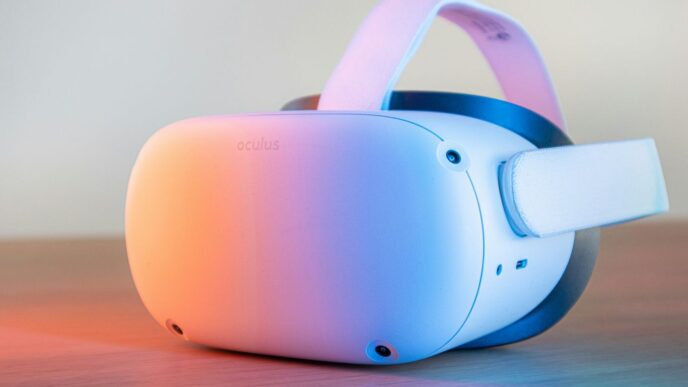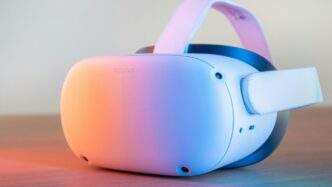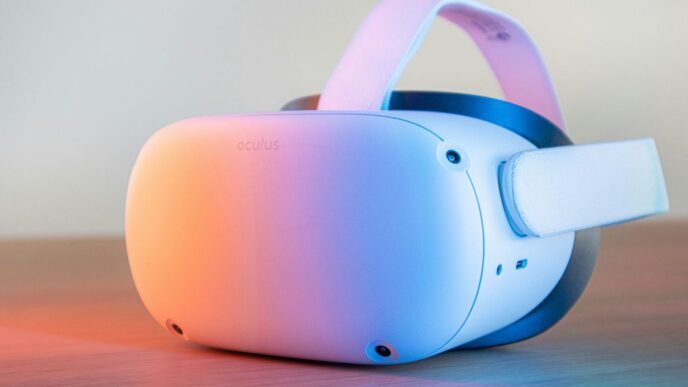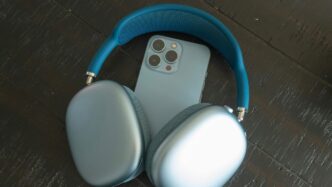So, Apple finally dropped the Vision Pro glasses, and everyone’s talking about it. It’s a big deal, for sure, and it costs a pretty penny. We’re going to break down what you actually get in the box and what it’s like to use these vision pro glasses. Think of this as a look at what Apple is doing with spatial computing and if these vision pro glasses are worth the fuss right now.
Key Takeaways
- The Apple Vision Pro headset itself is the main event, featuring a premium design and advanced technology for a new kind of digital interaction.
- Accessories like light seals and headbands aim to improve comfort and the immersive experience of the vision pro glasses.
- Advanced features like eye tracking and Optic ID show Apple’s focus on intuitive control and security within the vision pro glasses.
- The vision pro glasses represent a new era of spatial computing, blending digital content with the real world in novel ways.
- While impressive, the first-generation vision pro glasses have limitations, but they point towards a promising future for this technology.
Unpacking The Vision Pro Glasses Experience
Alright, let’s get into what you actually get when you bring home the Apple Vision Pro. It’s a pretty big deal, and the box itself feels like the start of something new.
The Centerpiece: Apple Vision Pro Headset
The main event, obviously, is the headset. It feels solid in your hands, not too heavy, but definitely has a premium weight to it. Apple really put thought into the materials; the part that rests against your face is soft, and the overall look is pretty sleek. It’s clear this is meant to be a high-end device, and the headset itself is the biggest clue.
Essential Accessories For Enhanced Use
Apple doesn’t just give you the headset and call it a day. There are a few bits and pieces that come along to make things work better.
- Light Seals: These magnetic pieces are designed to block out extra light, which is pretty important if you want to get really immersed. They snap on easily.
- Headbands: You get a couple of options here, like a solo knit band and a dual loop band. The idea is to help distribute the weight so it’s more comfortable to wear for longer periods. It’s a nice touch.
- Optical Inserts: If you wear glasses, this is a big one. Apple offers prescription lens inserts that attach magnetically. It means you don’t have to wear your regular glasses inside the headset, which is a huge plus for comfort and fit.
- Battery Pack: The headset doesn’t have a battery built-in; it uses an external pack connected by a cable. This keeps the headset lighter on your head, but it does mean you have a cable to manage.
Understanding The Vision Pro Travel Case
For a device this expensive, keeping it safe when you’re not using it is a must. Apple includes a soft white travel case. It’s designed to protect the headset and its components. While it’s not a hard-shell case, it feels sturdy enough for carrying it around, say, between rooms or if you’re taking it to a friend’s place. It’s a simple addition, but it shows they’ve thought about the whole ownership experience, not just the tech itself.
First Impressions Of The Vision Pro Glasses
Alright, let’s talk about what it’s actually like to hold and wear the Apple Vision Pro for the first time. Forget the specs for a second; what’s the immediate feeling?
Premium Build Quality And Design
When you first pick up the Vision Pro, it feels… substantial. Not heavy in a bad way, but like it’s made of good stuff. It’s got this sleek, almost minimalist look that Apple is known for. It’s definitely a step up from some of the more plasticky VR headsets out there. The materials feel really nice to the touch, and the overall design is pretty striking, almost like a pair of high-tech ski goggles. It’s clear they put a lot of thought into how this thing looks and feels, which is important when you’re strapping it to your face.
Comfort And Ergonomics Of The Headband
Putting it on is where things get interesting. Apple included a couple of different strap options, which is a good sign. I tried the solo knit band first, and it felt okay, but the dual loop band really made a difference. It seemed to spread the weight out a bit better, making it feel less like it was all pressing down on my nose. It’s not exactly feather-light, but for what it is, it’s surprisingly comfortable for short periods. Adjusting it to get a good fit took a little fiddling, but once it was dialed in, it stayed put.
Comparing Vision Pro To Other VR Headsets
So, how does it stack up against what’s already out there? Compared to something like a Meta Quest 2, the Vision Pro feels like it’s from a different planet in terms of build. It’s lighter than I expected, and the materials just feel more premium. The display, while not perfect (we’ll get to that), seems sharper in some ways. However, the Quest 2 is way more affordable and has a huge library of games already. The Vision Pro feels more like a first-generation glimpse into something new, rather than a direct competitor for gaming right now. It’s more about the spatial computing aspect than just VR games, which is a big difference.
Exploring Vision Pro Glasses Technology

Advanced Eye Tracking System
So, the Vision Pro has this really neat eye tracking thing going on. It’s how you control stuff, basically. Instead of clicking or tapping, you just look at what you want. It uses a bunch of tiny cameras and infrared lights to see exactly where your eyes are pointing. It’s pretty wild when you think about it. They make you look at a few dots when you first set it up, kind of like calibrating it to your specific eyes. It seems to work by bouncing light off your pupils and seeing how it reflects back. This gaze-based control is a big part of what makes the Vision Pro feel so different.
Optic ID Authentication
This is another cool security feature. It’s called Optic ID. It’s like Face ID, but for your eyes. It scans your iris and even checks how your pupil dilates. This is supposed to be super secure, way more than just a password. It’s all part of making sure only you can access your stuff on the device. It’s pretty advanced stuff, honestly.
The Role Of Infrared LEDs And Cameras
These little guys are the workhorses behind the eye tracking and Optic ID. You can’t really see the infrared LEDs, but they’re constantly sending out light. The cameras then pick up how that light bounces off your eyes. They track the patterns and reflections to figure out your gaze direction and identify you for Optic ID. It’s a clever system that works without you really noticing it. It’s how the glasses understand what you’re looking at and where you are.
Vision Pro Glasses: A Glimpse Into Spatial Computing
Redefining Digital Content Interaction
So, what exactly is this ‘spatial computing’ thing Apple keeps talking about with the Vision Pro? It’s basically a new way to think about how we use computers. Instead of looking at a flat screen, you’re interacting with digital stuff that feels like it’s actually in the room with you. Imagine browsing the web, but the web pages are floating in front of you, and you can just reach out and move them around. It’s pretty wild.
This isn’t just about watching movies on a giant virtual screen, though that’s part of it. It’s about making digital information feel more present and usable in our physical world. Think about looking at a 3D model of something for work, or maybe even seeing virtual furniture placed in your actual living room before you buy it. The Vision Pro aims to blend our digital lives with our physical surroundings in a way we haven’t really seen before.
The Future Of Augmented And Virtual Reality
Apple is clearly betting big on this. They’re not just making another VR headset; they’re trying to create a whole new category. It’s like when the first iPhone came out – it changed how we thought about phones.
Here’s a quick look at how it stacks up:
- Virtual Reality (VR): This is when you’re fully immersed in a digital world, like playing a game where you’re actually in the game. The Vision Pro can do this.
- Augmented Reality (AR): This is when digital things are overlaid onto your real world. Think of those filters on social media, but way more advanced. The Vision Pro leans heavily into this.
- Spatial Computing: This is Apple’s term for the Vision Pro experience. It’s like AR, but with a focus on interacting with digital content as if it were a physical object in your space.
It feels like a big step towards what science fiction has been showing us for years. We’re moving beyond just looking at screens to actually interacting with digital elements in three dimensions.
Apple’s Venture Into New Technological Frontiers
Apple has a history of taking existing technology and making it feel new and accessible. They did it with music players, phones, and watches. Now, they’re tackling spatial computing. It’s a huge undertaking, and the Vision Pro is their first big swing.
They’ve packed it with some pretty advanced tech:
- Eye Tracking: The headset knows where you’re looking, so you can select things just by gazing at them.
- Hand Tracking: You can use gestures with your hands to control things, like pinching to select.
- High-Resolution Displays: The screens inside are incredibly sharp, making digital objects look pretty realistic.
It’s definitely a first-generation product, so there are things that could be better, like battery life or maybe the weight for some people. But it’s clear Apple sees this as the next big thing in personal technology. They’re not just releasing a gadget; they’re trying to define the future of how we interact with computers and information.
Vision Pro Glasses: Setup And Initial Use
Navigating Initial Setup Challenges
Getting the Apple Vision Pro up and running for the first time can feel like a bit of a puzzle. It’s not quite as simple as just putting on a pair of glasses, that’s for sure. You’ll want to make sure it’s charged up before you even start, which is a good first step. Then comes syncing it with your Apple ID, connecting to Wi-Fi, and getting the fit just right. The calibration process is key to a good experience. It involves adjusting the headbands and making sure the display looks clear. It took me a few tries to get everything dialed in perfectly, but the instructions provided are pretty clear, even if you’re not super tech-savvy. It’s a good idea to have some patience here; rushing it will just lead to frustration.
Learning The Interface And Controls
Once you’re past the initial setup, you’ll need to get acquainted with how to actually use the Vision Pro. It’s all about eye tracking and hand gestures. You look at what you want to select, and then you pinch your fingers together to click. It sounds simple, and for the most part, it is. But there’s a learning curve. You’ll find yourself accidentally selecting things or missing your target at first. It’s a bit like learning to type all over again, but with your eyes and hands.
Here’s a quick rundown of the basic controls:
- Look: Simply gaze at an element on the screen.
- Pinch: Make a small pinching motion with your thumb and index finger to select.
- Scroll: Use a larger pinch gesture and move your hand up or down.
- Home Gesture: Bring your wrist up towards your face to return to the main view.
It’s definitely different from using a mouse or a touchscreen, but it feels quite futuristic once you get the hang of it. You can find more detailed setup steps on powering on and getting started.
First Visual Impressions Of The Display
Okay, so what’s it like looking through the Vision Pro? The display is sharp, no doubt about it. Colors are vibrant, and the resolution is impressive, making digital content look really solid. However, I did notice a slight graininess, especially in certain lighting conditions or when looking at very fine details. It wasn’t a deal-breaker, but it was there. It’s something you get used to fairly quickly, and the overall immersion is still pretty strong. For a first-generation product, it’s a remarkable display, but there’s definitely room for improvement in future versions. The clarity is good enough for browsing the web and watching videos, which is a big part of what this device is for.
Real-World Vision Pro Glasses Applications

So, what can you actually do with the Apple Vision Pro once you get past the initial setup and marvel at the display? It’s more than just a fancy gadget; it’s starting to show us how we might interact with digital stuff in new ways.
Web Browsing and Media Consumption
First off, browsing the web feels pretty different. Instead of a flat screen, you can pull up websites like they’re floating in front of you. Imagine having multiple browser windows open, arranged however you like in your own space. It’s kind of like having a massive, customizable monitor that follows you around. Watching videos is also a big deal. You can make the screen as big as you want, turning your living room into a personal cinema. YouTube videos, movies, TV shows – they all get a serious upgrade in scale and immersion. It really changes how you consume content, making it feel much more present.
Immersive Virtual Environments
This is where things get really interesting. The Vision Pro lets you step into entirely different places. You can visit virtual environments that look incredibly realistic. One minute you might be standing on a mountaintop, the next you’re exploring the ocean floor. It’s not just about looking at a picture; it’s about feeling like you’re there. You can interact with digital objects too. Some early testers have talked about seeing dinosaurs walk around their room or playing with virtual characters. It’s a whole new level of engagement that traditional screens just can’t match.
Taking Vision Pro Glasses Outdoors
Okay, so taking these things outside is a bit of a mixed bag right now. It’s not exactly designed for a casual stroll in the park. The battery life is a consideration, and you’re pretty cut off from your surroundings visually, which can be a safety concern. However, there have been some interesting tests. Imagine virtually visiting famous landmarks while actually standing in your backyard, or experiencing a different weather condition overlaid on your real environment. It’s more about bringing the experience of being somewhere else to your current location, rather than actually being physically present in a new place. It’s a glimpse into augmented reality that’s still finding its footing, but the potential for remote exploration and virtual tourism is definitely there.
Assessing The Vision Pro Glasses Potential
So, we’ve spent some time with the Apple Vision Pro, and it’s time to talk about what this thing might actually mean for the future. It’s definitely a first-generation product, and you can feel that in some ways. But there’s also this undeniable spark of something new here.
Unique Virtual Interactions
One of the standout things is how you interact with digital stuff. It’s not just about looking at a screen anymore. You can actually reach out and manipulate objects in 3D space. Imagine editing a video by just grabbing the timeline and pulling it around, or having a virtual pet that you can actually feed and play with using your hands. It feels pretty wild, honestly. The way it blends digital elements with your real surroundings is pretty impressive, making things feel more present than just a flat display.
Acknowledging First-Generation Limitations
Now, let’s be real. This isn’t perfect. The battery life, for starters, isn’t exactly all-day. You’ll be tethered to a power source or swapping out packs if you plan on extended use. And while the display is sharp, there’s a slight graininess that you notice sometimes, especially in certain lighting. It’s not a dealbreaker, but it’s there. Also, the amount of content specifically made for this platform is still pretty small. You can browse the web and watch videos, sure, but the truly mind-blowing spatial apps are still on their way. It’s a bit like having a super-advanced tablet with no apps yet.
Future Promise Of Spatial Computing
Despite the current hiccups, the potential is huge. Apple is calling it ‘spatial computing,’ and it really does feel like a new way to compute. Think about collaborating on a 3D model with someone across the globe, or attending a virtual concert that feels like you’re actually there. This device is a big step towards that. It’s a glimpse into a future where our digital and physical worlds blend in ways we’re only just starting to imagine. It’s a substantial investment, but it’s also a look at Apple’s venture into new technological frontiers.
Here are some things to keep in mind as you think about its future:
- Content Ecosystem: The growth of apps and experiences designed specifically for Vision Pro will be key.
- Hardware Iterations: Future versions will likely address current limitations like battery life and display clarity.
- Developer Adoption: How quickly developers embrace this new platform will shape its capabilities.
- Price Point: While high now, future accessibility could broaden its impact.
So, What’s Next?
Alright, so we’ve taken a good look at what Apple’s Vision Pro is all about. It’s definitely a big step, and honestly, it feels like the start of something new. It’s not perfect, and yeah, the price tag is pretty steep, but you can see where they’re going with this. It’s going to be interesting to see how people actually use this thing day-to-day and if it changes how we do things online or in our homes. For now, it’s a glimpse into a possible future, and we’ll just have to wait and see how it all plays out.
Frequently Asked Questions
What exactly is the Apple Vision Pro?
Think of the Apple Vision Pro as a super advanced computer that you wear on your face. It’s not just for games; it lets you see digital stuff mixed with the real world, like floating screens or virtual characters in your room. Apple calls this ‘spatial computing’.
What comes in the box with the Vision Pro headset?
When you get the Vision Pro, it comes with the headset itself, which is the main part. You also get things like a special band to wear it comfortably, a battery pack that you connect, a cloth to keep the lenses clean, and some seals to block out extra light. Sometimes, there are also special lens inserts if you need glasses.
How do you control the Vision Pro?
Instead of using a mouse or touching a screen, you control the Vision Pro mostly with your eyes and hands. It has amazing cameras and lights that track where you’re looking and how your fingers move, letting you select things and scroll just by using your gaze and simple hand gestures.
Is the Vision Pro comfortable to wear?
Apple put a lot of effort into making it comfortable. It has soft materials and adjustable bands, like a special head strap, to help spread out the weight. While it’s a bit heavy, many people find it surprisingly comfy for wearing for a while, especially with the right adjustments.
Can I use the Vision Pro if I wear glasses?
Yes, you can! Apple knows many people wear glasses, so they offer special lens inserts. These magnetic lenses can be popped right into the Vision Pro, fitting over your own glasses so you can see clearly without any hassle.
What’s the point of the battery pack?
The Vision Pro needs a lot of power to run all its fancy screens and sensors. The battery pack, which you connect with a cable, holds all that power. It’s designed to last for a few hours and keeps the headset itself from being too heavy on your head.














